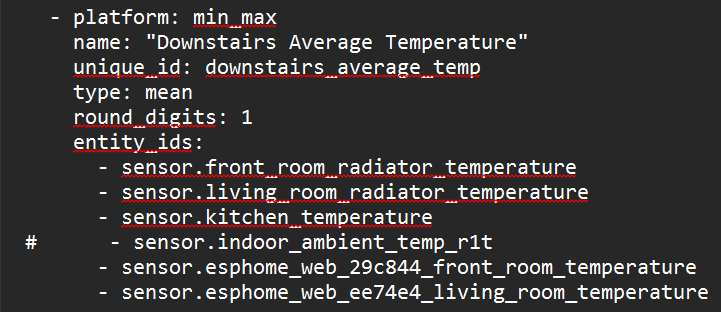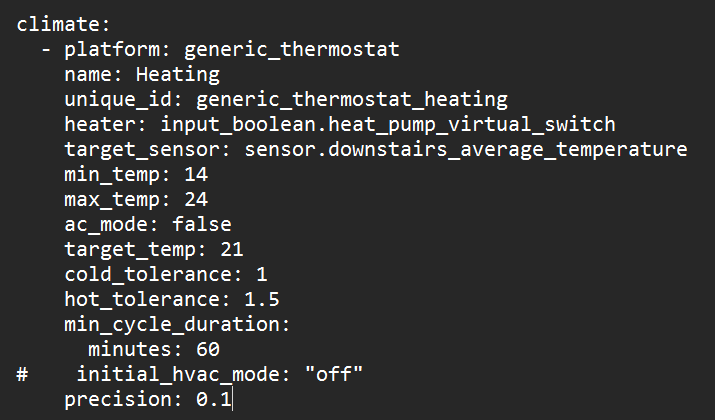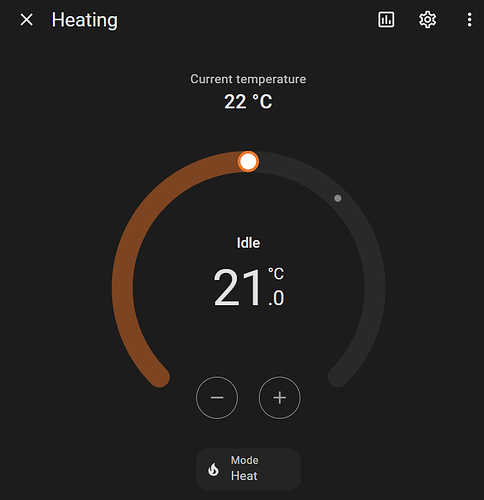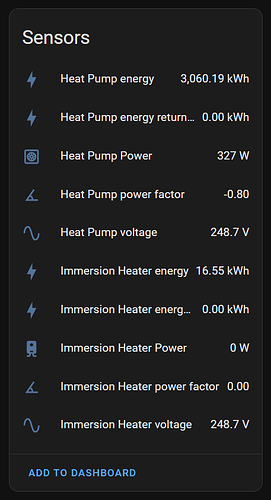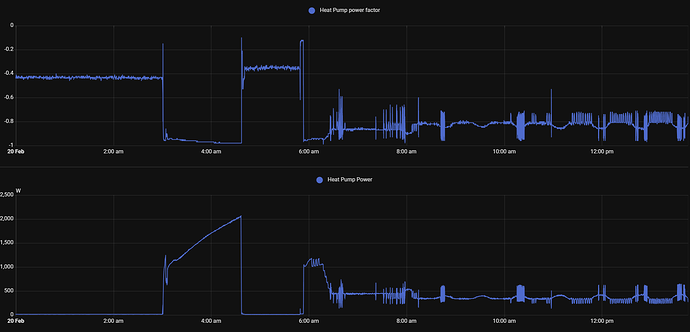My RT6 is currently reporting 6C while its snowing…
Now its looking more believable.
I mounted a 3rd party temp sensor next to R6T and also saw somewhat high readings.
Unscrewed the R6T temporarily and left it swinging in the breeze and did the same for the 3rd party sensor.
It seems both the Daikin R6T and 3rd party sensor were 2C+ warmer when on that wall (north east facing).
That wall where the sensor was happens to back onto my internal meter cupboard…
Note the 8.6C/9.6C, happened to catch it on a defrost.
But prior to the defrost it was inline with the other sensors
You can also set the ambient temp to be averaged over a number of hours. It’s [1-0A] on the field settings - values:
“0: No averaging
1: 12 hours
2: 24 hours
3: 48 hours
4: 72 hours”
I haven’t tried it, 6 hours would be sensible, but 12 seems bit long. Maybe I should, and see what happens…
1 hour increments would be helpful up to 6 hours imo. Could overcome small spikes if there is a bit of direct sunshine at parts of the day.
Unless an unoccupied house I can’t imagine how a 12+ hour average helps unless some places don’t see the same temperature swings we see here in the UK. Maybe if it was a forwards looking average based on a forecast, but not sure how a backwards looking average is helpful.
Just another Daikin design decision that on the face of it doesn’t make much sense ![]()
I need some help figuring out which include file to use in ESPAltherma.
I have the Altherma ELBH12E6V (indoor) and ERRA08EW1 (outdoor).
I have been experimenting with ‘Pure Weather Compensation’ ie no external controls.
It’s been very successful at heating our house maybe a bit too much, our 8kW unit can modulate down and consume a small amount of steady state electric ~300W but the house is still too hot (especially upstairs) even after throttling/balancing the radiators, I guess there is such a thing as a too well insulated house.
So i am now experimenting with a hybrid model and using Home Assistant.
1st I take an average temp downstairs this smooths out human, oven and multiple computer heat directly affecting the single point modoka sensor in one room.
Then I created a Generic Climate entity that has a setpoint, hysteresis, cycle time, and a virtual Switch (a simple helper (input_boolean))
UI Result and control
Within Node Red I can then trigger the HP on/off via the HACS integration, I also have a simple check state, so it’s does not keep hitting the API.
Time will tell, but I think the HP will run 24/7 when the outside is 3 or below following the WDC, but when outside is above this the house will get above the hysteresis and turn off the HP.
So far so good, i turned off the heating at mid-day yesterday and enabled the automation, the heating only turned back on at 6am, its been mild for sure, but even heating at the lowest setting would have used more electric than my on/off + Pure WDC; waiting for a cold spell now.
The Downstairs is the reference point, so the heat from the Front Room will flow to the Livingroom without stopping like the Madoka that’s in the Front Room, we have all doors open ![]() trying to balance the upstairs rads down next, to reduce the temps…
trying to balance the upstairs rads down next, to reduce the temps…
Hi @tiger_cook
I did manage to get the mods to upload to that post the corrected template, sorry this took a while, I didn’t see your message straight way.
The post is locked for editing unfortunately (unless a mod does it for you)
I’ve read this thread with interest as a new owner of a Daikin Altherma 3.
With regards to accurate power measurement, I thought that CT clamps were unreliable for heat pumps because of the inductive load and power factor. It seems better to put in an inline DIN-rail-mounted monitor, along the lines of the level 3 monitoring kit. Do people have experience of these? Ideally I’d like something accurate that provides Z-Wave or WiFi connectivity natively rather than needing to use an additional device connected via Modbus to send the data wirelessly to Home Assistant. The Qubino Smart Meter looks potentially attractive- has anyone tried those? I’d prefer something that can’t switch the circuit on and off but just monitors power, voltage, current, etc.
Alternatively, am I over complicating things and is a CT clamp-based approach accurate enough here?
If you have in mind the devices that don’t measure voltage, but allow the user to set a “typical” or “average” voltage - which might be little better than guesswork, then it’s impossible to treat the values they come up with as anything better than pure guesswork, your thinking is indeed correct. However, if you have the emonTx4, emonTx5 or the emonPi2 in mind, then the accuracy of both is broadly comparable with meters such as the SDM120, the major difference being the SDM120 is certified for accuracy. We claim an overall accuracy of ±1.2% for the emonTx4, emonTx5 and the emonPi2, compared to 1% for the SDM120 and if you want to monitor more than two circuits, or one in the case of the Qubino, then there’s probably a cost advantage for the OEM units too.
One question worth finding the answer to is, do you have free and unfettered access to the data from the Qubini meter you’re interested in, or will you at some future date find some central service has become paid-for or maybe worse, unavailable? I didn’t see anything with a swift look at the website, which in itself makes me suspicious.
I use a CT clamp and the values coming off it, when converted to kwh are within +/-1kwh of what the MMI claims it has consumed. Close enough for me.
But you’re using what to convert the current transformer output into kWh? It might help @NikNakk to know this.
If that was directed at me, in my case it’s a bit convoluted. It’s a Smappee clamp which I can’t directly integrate with Home Assistant, so first the data is polled by a python script to bring it into influxdb (I was doing that for a long time before I started with HA). From there, HA imports the influxdb data and takes the raw watts presented to the CT clamp and pipes them into an Integral helper to do a ‘Left Riemann sum’ on it. The output of this goes into a ‘Utility Meter’ helper which does a daily reset giving me input kWh every day.
I’m sure there are probably easier ways ![]()
As far as I understand communicates locally using Z-wave, not to a cloud service, and has been around for a few years. Thanks for the suggestion about looking further into the emonPi2. I’d had the misunderstanding that most devices with CT clamps were measuring current and using a fixed multiplier, but on further reading I’ve seen that both the emon devices and the Shelly EM devices (for example) can handle voltage and current being out of phase.
Massive thanks to Stephen and this thread. Think I finally have it working with an M5StickC Plus2 and Shelly energy monitor!
This thread is brilliant - I’ve got my M5StickC Plus2 setup, code built and downloaded, but I don’t see anything on the screen at all - is that normal?
I’m planning to buy the Shelly Pro EM - I assume that’s the right one, and put the CT clamp around the HP’s live feed. Do I need to do anything with the other CT clamp as it’s a dual channel monitor?
Thanks to all - this thread has been incredibly helpful! ![]()
The Shelly Pro EM is good, One CT for the HP and the other for the immersion heater
Shelly EM (SHEM)
by Shelly
Firmware: 20230913-114150/v1.14.0-gcb84623
Hardware: gen1
Hi Neil
Out of curiosity what is Heat Pump power factor -0.80?
Where does this device get the voltage from?
maybe this will help?
&
https://community.shelly.cloud/topic/1174-power-factor-a-good-explainer/
and the Voltage is from the devices input itself, PS I am running from Battery and Solar at the moment
Thanks Neil,
So the power factor is an adjustment made to the power drawn from the grid to take account of the fact that not all that power actually goes to running the device due to inefficiencies?
So for example, the heat pump circuit is drawing 1,000W from the grid but the circuit is only 81% efficient so 810W is reported as being consumed by the device rather than 1,000W
Have I understood that correctly?



